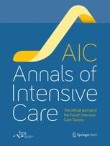Citation Impact 2023
Journal Impact Factor: 5.7
5-year Journal Impact Factor: 6.0
Source Normalized Impact per Paper (SNIP): 1.749
SCImago Journal Rank (SJR): 2.061
Speed 2023
Submission to first editorial decision (median days): 7
Submission to acceptance (median days): 91
Usage 2023
Downloads: 1,737,465
Altmetric mentions: 6,851
Sedation in French intensive care units: a survey of clinical practice
Sedation is used frequently for patients in intensive care units who require mechanical ventilation, but oversedation is one of the main side effects. Different strategies have been proposed to prevent oversed...
